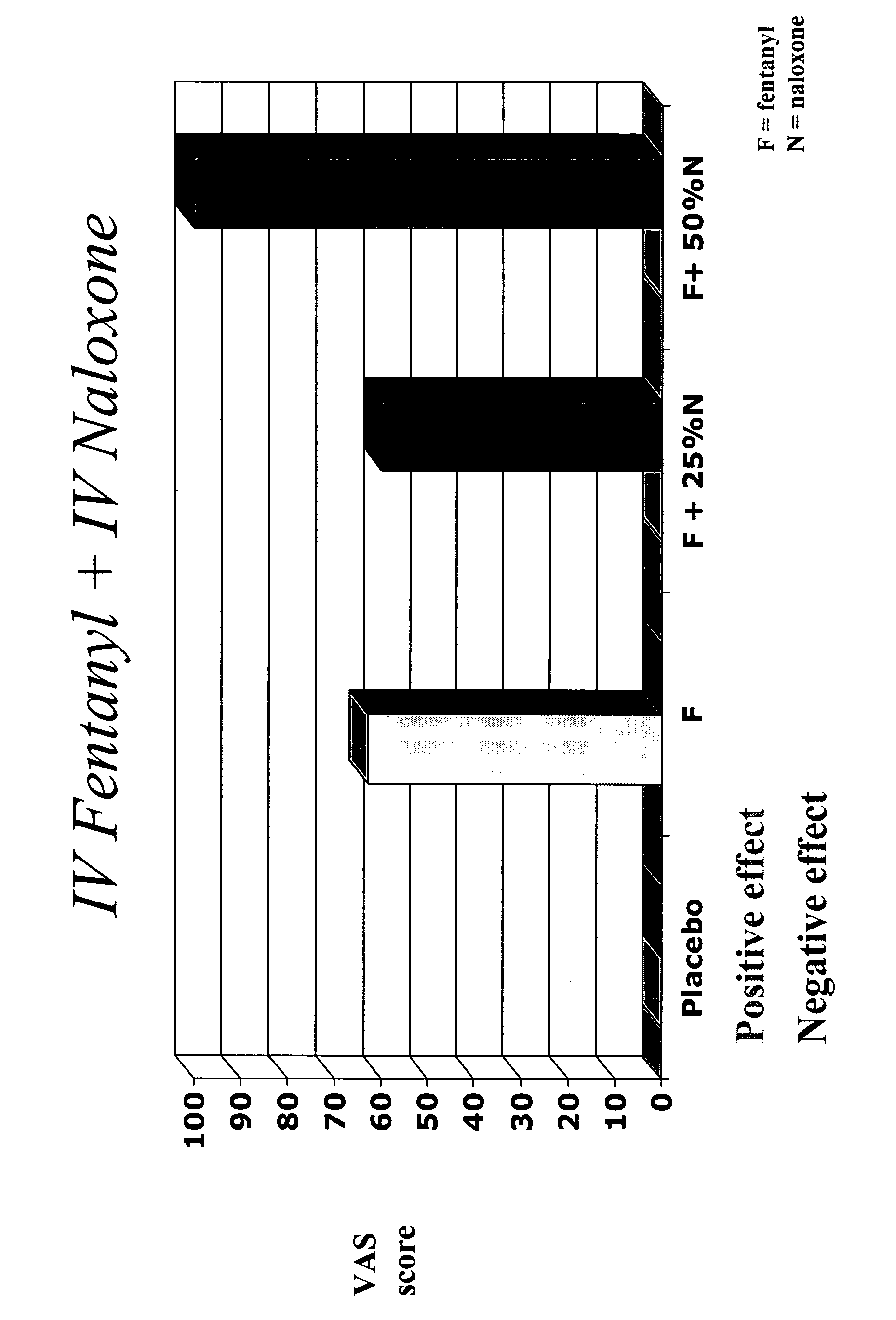Abuse resistant transmucosal drug delivery device
a transmucosal and drug technology, applied in the direction of nervous disorders, organic active ingredients, drug compositions, etc., can solve the problems of increasing the risk of undesirable accompanying symptoms, affecting the activity of opioid analgesics, etc., and achieve the effect of reducing the illicit abuse potential and preventing the abuse of drugs
- Summary
- Abstract
- Description
- Claims
- Application Information
AI Technical Summary
Benefits of technology
Problems solved by technology
Method used
Image
Examples
example 1
Effect of Naloxone on Efficacy of Fentanyl
[0089]The purpose of this study is to determine the dose range over which IV naloxone administered in combination with IV fentanyl, would precipitate opioid withdrawal signs and symptoms and attenuate any pleasurable effects from intravenous injection in subjects with a moderate level of opioid dependence. It is believed that the addition of this ratio of naloxone to a transmucosal formulation of fentanyl would hinder or prevent abuse.
[0090]The trial was a randomized, double-blind, placebo controlled, within-subject crossover study in opioid-dependent volunteers. Subjects were maintained on methadone prior to inpatient admission and throughout the 9-day study period. Subjects received each of the 5 study doses and evaluated the psychopharmacologic effects of each.
[0091]The subjects included males or non-pregnant and non-lactating females; 18 to 55 years of age; free from any significant clinical abnormalities on the basis of medical history ...
example 2
Extraction of Fentanyl and Naloxone in Water and Ethanol
[0106]A 3.11 cm2 bilayered transmucosal disc was placed in 100 mL of 0.1N HCl and 0.1N NaOH. The disc was allowed to dissolve over a period of 30 minutes, and the amount of naloxone was measured using a high performance liquid chromatography. At 30 minutes, 100% naloxone and 100% fentanyl was extracted under acidic conditions, while 15% naloxone and 2% fentanyl was measured at a pH 12. The remaining amount was expected to settle at the bottom of the flask with other insoluble excipients. A 3.11 cm2 bilayered transmucosal disc as described herein was placed in 100 mL of ethanol. HPLC results show both naloxone and fentanyl present.
example 3
Extraction of Buprenorphine and Naloxone in an Aqueous Solvent
[0107]A 2.3 cm2 disc containing buprenorphine in the mucoadhesive layer and naloxone in the backing layer was prepared and placed in pH 7.4 Phosphate buffered solution in a Van Henkel USP dissolution apparatus at 50 RPM. The result of the dissolution experiment is shown in the table below.
[0108]
Number of Minutes inAqueous SolventBuprenorphineNaloxone518.0%20.3%1538.5%48.0%3060.5%72.1%4584.1%83.2%60100.2%86.2%75106.7%86.2%120108.9%85.8%180109.4%87.4%
[0109]As can be seen in the table, naloxone and buprenorphine extract simultaneously up to 180 minutes. Thus, they can not be extracted separately via dissolution.
PUM
| Property | Measurement | Unit |
|---|---|---|
| residence time | aaaaa | aaaaa |
| residence times | aaaaa | aaaaa |
| residence times | aaaaa | aaaaa |
Abstract
Description
Claims
Application Information
 Login to View More
Login to View More - R&D
- Intellectual Property
- Life Sciences
- Materials
- Tech Scout
- Unparalleled Data Quality
- Higher Quality Content
- 60% Fewer Hallucinations
Browse by: Latest US Patents, China's latest patents, Technical Efficacy Thesaurus, Application Domain, Technology Topic, Popular Technical Reports.
© 2025 PatSnap. All rights reserved.Legal|Privacy policy|Modern Slavery Act Transparency Statement|Sitemap|About US| Contact US: help@patsnap.com

